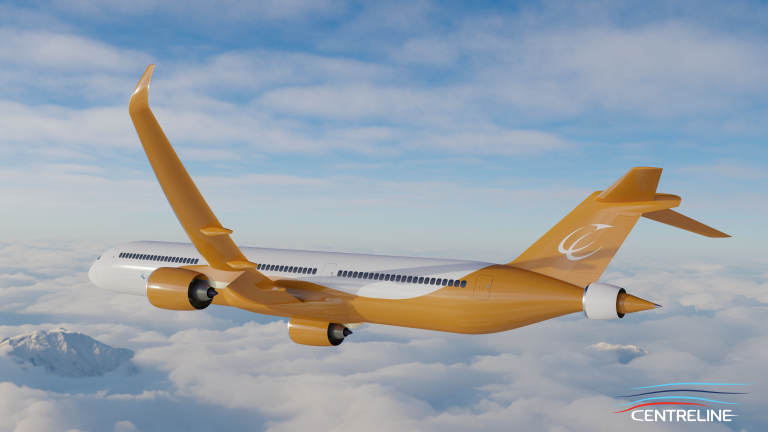The so-called Propulsive Fuselage Concept (PFC) has the potential to play a key role in developing more efficient and less polluting airplanes of the future. The turbo-electric variant of a PFC aircraft for 340 passengers produces 4.7% less CO2 emissions and 20% less cruise NOx emissions compared to an equally advanced conventional aircraft.
In addition to the two gas turbines on the wings, an electric fan is located at the aft-fuselage to produce thrust by ingesting and re-energising the airflow around the fuselage. The PFC configuration features excellent compatibility with other advanced technologies including hydrogen fuel technology.
The consortium of CENTRELINE project has managed to complete the proof of concept and experimental validation for this highly promising technology thereby maturing it to Technology Readiness Level (TRL) 3 and bringing it closer to a possible industrial uptake in the future:


Fuselage wake-filling propulsion known from ships
The ingestion and re-energisation of the fuselage boundary layer flow by the propulsion system, so-called fuselage wake-filling propulsion integration, is a yet untapped source of further efficiency improvements in aviation. However, the positive effect of “wake-filling” on propulsive power requirements has long been known from the field of marine propulsion. Ship propellers are typically located at the aft body of the vessel and operated within the boundary layer flow close to the ship’s body surface. This physical principle is also applicable to airborne propulsion, as the 11 CENTRELINE partners of six European countries have just proven.
Cleaner long-distance flights
Appropriate conceptual design solutions were developed for the key challenges specific to a turbo-electric PFC aircraft and were verified by suitable experimental and numerical methods. All detailed design and analysis results were incorporated in a multi-disciplinary aircraft family pre-design and the PFC technology was rigorously benchmarked against a similarly advanced but conventional aircraft
The evaluation was performed for
- the highly impactful mid-to-long range air transport task
- featuring 340 passengers
- and 6500 nmi (~12,000 km) design range in the year 2035.
It shows
- -11% CO2 reduction potentials under idealised conditions and -4.7% CO2 for the turbo-electric PFC against the advanced reference aircraft or -36% relative to a year 2000 baseline,
- -1.8% PFC NOx (Nitrogen Oxides) emissions during the ICAO Landing and Take-off (LTO) cycle relative to the year 2035 reference, and -41% compared to the year 2000 baseline and
- during cruise (high-level) -20% NOx emissions (-64% against year 2035 and 2000 standards).
Synergistic compatibility with other promising technologies, such as
- revolutionary core engines (such as the Composite cycle Engine, CCE),
- High-Temperature Superconducting (HTS) technology,
- ultra-efficient wing technologies (such as Natural Laminar Flow, NLF, wings as demonstrated by the BLADE demonstrator in Clean Sky), and liquid hydrogen (LH2) fuel technology.
CENTRELINE Background
- CENTRELINE stands for “ConcEpt validatioN sTudy foR fusElage wake-filLIng propulsioN intEgration”.
- Partners: Bauhaus Luftfahrt (Project coordinator), Airbus Defence and Space, Airbus Operations, MTU Aero Engines, Rolls-Royce and Siemens, Chalmers University of Technology, Delft University of Technology, the University of Cambridge and Warsaw University of Technology, ARTTIC Innovation GmbH and ARTTIC SAS.

CENTRELINE has received funding from the European Union's Horizon 2020
research and innovation programme under grant agreement No. 723242.
Further Reading
Summary paper: Proof of Concept Study for Fuselage Boundary Layer Ingesting Propulsion
Arne Seitz, Anais Luisa Habermann, Fabian Peter, Florian Troeltsch et al
